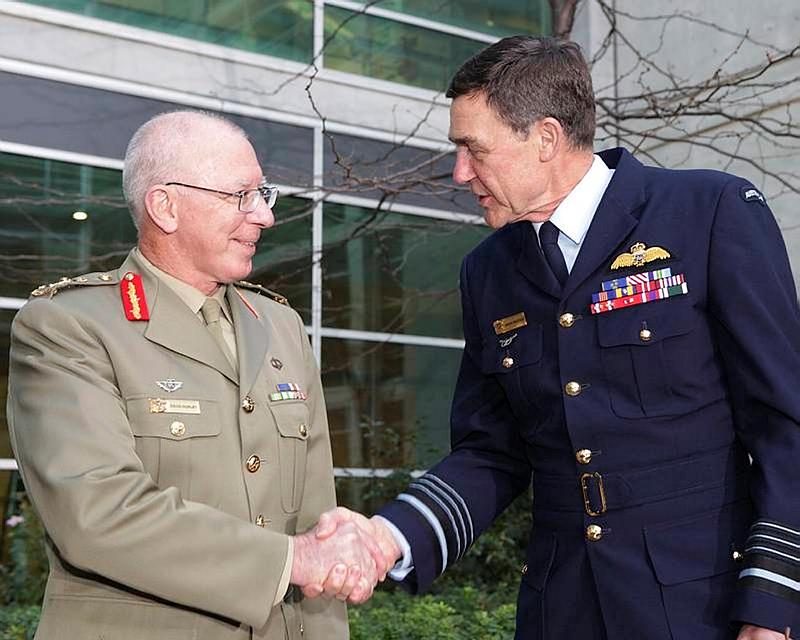 The headline gives you the guts of the idea. In the diarchy that runs Defence, the military man sits atop the civilian: the chief of the Australian Defence Force now looms above the secretary of the Defence Department.
The headline gives you the guts of the idea. In the diarchy that runs Defence, the military man sits atop the civilian: the chief of the Australian Defence Force now looms above the secretary of the Defence Department.
Forty years ago, the situation was reversed. The civilian Secretary then mattered more than CDF in the power and precedence hierarchy. Saying that the Chief of the Defence Force out-equals the other half of the diarchy is offering a judgement about both relative and absolute shifts in the power of the two jobs that sit, co-joined, atop Defence.
The Secretary still matters hugely, not least because of his considerable statutory powers, especially over money. The current Secretary, Dennis Richardson, is one of the great public servants of his generation and I’ve written a couple of posts (here and here) to that effect.
For all his formidable smarts and bureaucratic savvy, I suspect even Richardson would admit that the service side of the diarchy now has a standing with ministers that he can’t match. It’s more than just the mystique of the slouch hat. Politicians have changed the power settings; that has meant the relative clout of the Secretary has declined considerably from the high point achieved by Arthur Tange. The Secretary’s ability to faze or out-face his minister has declined as sharply as his capability to dominate the CDF. Indeed, the Secretary’s ability even to hold onto his job has changed dramatically.
Consider five factors in CDF’s diarchy dominance:
- The CDF job has taken controlling power within the military to match his title, through jointery and taming the service chiefs.
- The relative power of the Secretary has declined because the Canberra mandarins are extinct. Ministers have killed mandarins both as a class and as a state of mind.
- The Canberra officer project demands that political nous becomes part of the standard kit of military professionalism. This political element is the most sensitive and controversial element of the project, to be discussed later in this series.
- The ADF has been deployed on operations continuously since 1999. When at war, the warrior chief steps up.
- Time at the top. The longevity calculus has been reversed. Today, senior officers stay in place long enough to see Secretaries come and go. The military is creating a ‘new’ tradition that the Vice CDF or a service chief will become CDF, giving them eight years at the top.
The Secretary’s dominance of the diarchy has clearly declined since it was created. Under the Tange model, the Secretary alone gave policy advice to the minister and the Secretary and his senior people tended to have much more time at the peak than ministers or the senior military. Bob Lowry gives a succinct view of how the system started out: ‘Tange was the constant star of the diarchy, partnered by a changing parade of military chiefs, and was therefore able to maintain primacy in areas of defence policy over which some military officers thought they should have more influence’. Tange’s office had the walnut panelling and the carpet; the Chief got more austere quarters with serviceable gyprock walls.
Des Ball wrote in a 1979 article on Australian Defence decision-making that
‘the Permanent Head is clearly the single most powerful individual in Australian defence decision-making. He has extraordinary capability not only to influence the Minister but also to resist his wishes or even his demands.’
The two words ‘Permanent Head’ tell the tale. Nothing permanent about that job now. The Commonwealth did away with permanent heads in 1984 and introduced fixed-term contracts for secretaries in 1994. Fixed term is a misnomer. Secretaries serve at the government’s pleasure/displeasure; the incoming Howard and Abbott governments beheaded some secretaries both to announce their arrival and encourage the rest.
Look at the previous half dozen Defence Secretaries. One was sacked and three were flicked elsewhere by ministerial fiat. The average term of an Australian company CEO is 4.4 years; none of the half dozen Secretaries made that mark.
What has happened in Defence is what has happened across Canberra. Peter Shergold, head of the public service as the PM’s Department Secretary (2003-08), argues that politicians cut down the mandarin class, of which Tange was one of the last great examples.
For Shergold, the golden age of the mandarin immortals was ‘marked by intense territorial warfare, the exercise of monopoly power, weak collegiality and—by contemporary standards—a lack of public accountability. To the extent that the departmental secretaries were stronger, ministers were weaker’.
Today, ministers are stronger and secretaries are weaker. And in Defence, the services have taken advantage.
Graeme Dobell is the ASPI journalist fellow. Image courtesy of the Department of Defence.